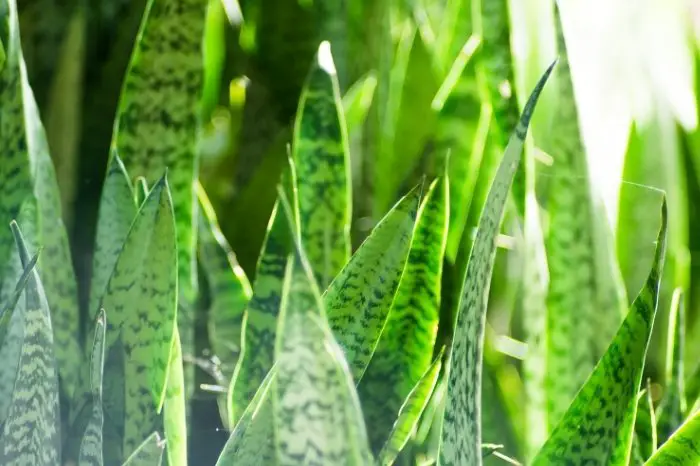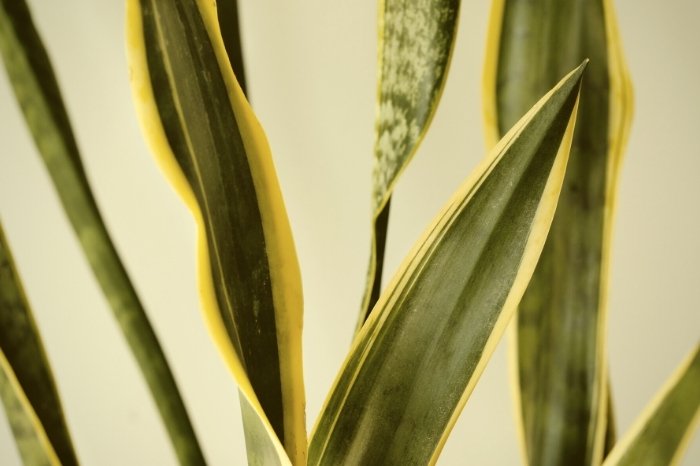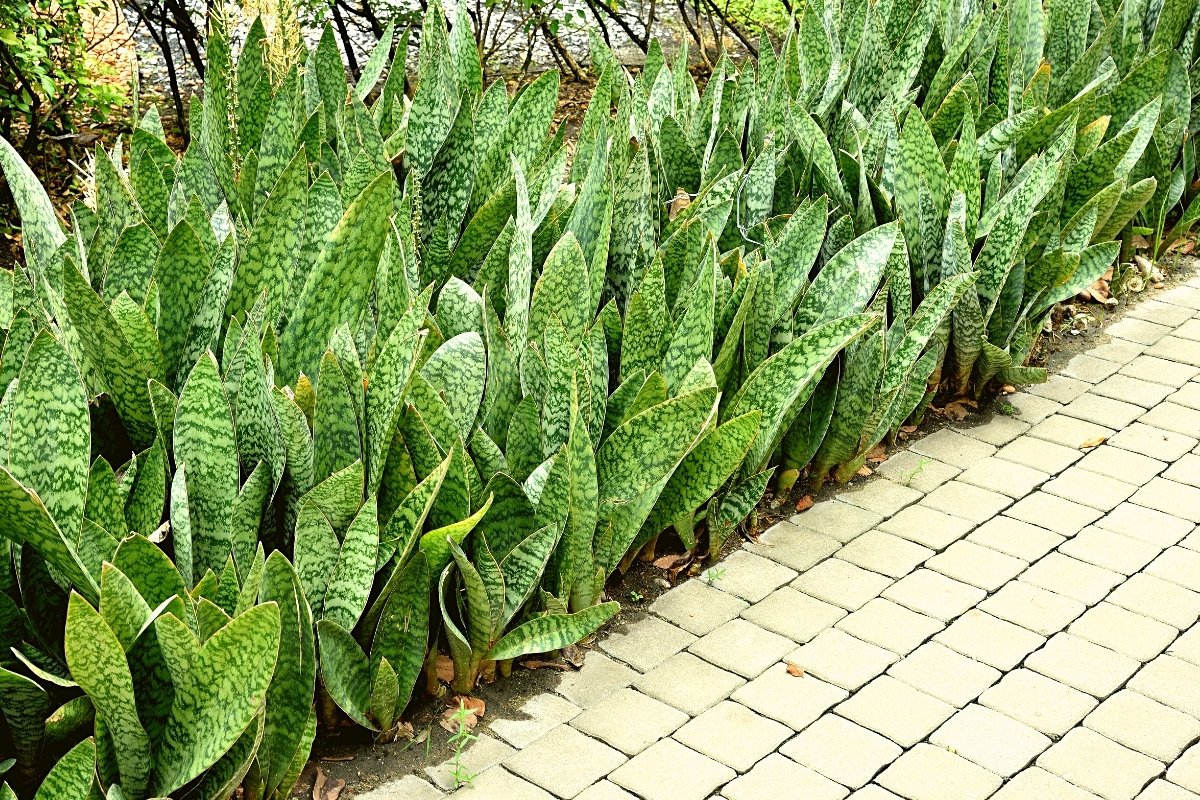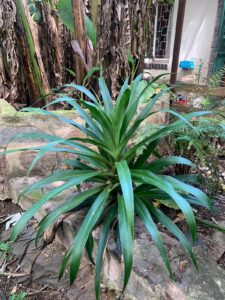Last Updated on March 2, 2023 by Griselda M.
Growing a snake plant outdoors is simple and easy if you know how to maintain them. Snake plants are very popular when it comes to modern gardening, but some gardeners ask can snake plants live outside. It’s well known that these plants need higher temperatures to thrive and that they’ll simply wilt if you leave them outside in the cold. In today’s article, we’ll be taking a look at how to care for these plants outside.
We also discuss vital points that include how long can snake plants live and other plant care aspects that aid them in thriving. The information below gives you an in-depth look at the best care and maintenance aspects when growing snake plants in your garden.
Keeping a Snake Plant Healthy
Snake plants are definitely tough – these robust plants can withstand many problems, but low temperatures are the biggest killers. This is why so many gardeners refrain from keeping these plants outside. However, it’s entirely possible to keep your snake plant outside, but there are a few things to look out for when you do.

Temperature – Can snake plants live outside?
This is going to be the biggest obstacle to overcome. Since snake plants are tropical plants, they’re used to high temperatures. If you live in a particularly warm area, you won’t have any trouble growing these plants outside. They prefer temperatures from 55 to 90 degrees Fahrenheit.
However, keep in mind that winter will eventually come and that temperatures will drop. If temperatures drop below 55 °F, your snake plant will die in a matter of days.
This is why some gardeners grow them outside, but keep them in large pots. That way, they can easily take them inside once colder weather starts to dominate the days.
Watering
This is one of those plants you don’t need to worry about when it comes to watering. Similar to cacti, they’re used to very little water, and they won’t mind if you leave them alone. You should only water them once the ground has completely dried up. They have water storage roots and will absorb and store what they need.
Overwatering them can become problematic and actually cause root rot, and this is something that very often happens with new gardeners. In other words, if you water your snake plant constantly, you’re going to cause root rot, and your entire plant could wilt!
When you’re planting your snake plant, make sure that you take it away from plants that need constant watering. If you don’t do that, you’ll accidentally water the snake plant too.
Lighting – Can snake plants live outside?
These plants need that golden middle when it comes to lighting. You shouldn’t keep them in direct, strong sunlight – this will dry the plant out. However, keeping them in an area that’s too shady will stop your plant from growing properly.
Because of this, it’s best to keep them in a spot with a lot of indirect sunlight – they like brightness, but not the directness of the sun.
Surviving The Winter
You’ll need to take your snake plants inside during the winter if the temperatures are going to drop below 55 degrees Fahrenheit. There’s no way that they can survive that, so it’s best to put them in pots and take them inside.
Because this is a necessary process (unless you live in hot areas), many gardeners keep their snake plants in large pots that they simply take inside when winter strikes. When they’re inside, keep them near a window, but not directly next to it. It would be good if the humidity of the room was high and if the temperature wasn’t too low.
Air Cleaning Indoor Plant Soil Mixture
These plants certainly don’t want you to keep them in the dark, as they like the light and will start wilting without it.
Additionally, it’s important to note that nothing changes regarding watering just because you took your snake plant inside – water it every six weeks and no more often than that.
Snake plants do much better during the summer than during the winter. During the summer, all you have to do is put them in a partially shaded area and let them rest. Winter, however, is often fatal for these plants if you don’t take them inside.
Check Out How To Grow Your Snake Plant Too Tall?
Diseases and Pest – Can Snake Plants Live Outside?
The most common problem with snake plants is root rot. This is, in almost 100% of cases, the fault of the gardener, as it often happens that gardeners overwater their plants. If you live in a particularly rainy area, your snake plant is not going to like you keeping it outside as they’ll often be overwatered by mother nature, so it’d be best to keep them inside.
In case you notice root rot, and that would be impossible not to notice (the leaves will start dying), it’s best to let the plant dry out completely after you remove all the dying leaves. The plant will recover on its own, so you don’t have to do anything to help it recover; just make sure that you don’t water it during that time.

How Do You Strengthen a Snake Plant?
These plants need light (if your winter photoperiod is less than 8 hours, install a supplemental light). Typically, a snake plant would need at least 8 hours, but it will not complain if you bump this up to 13 or more a day.
They also need good, well-aerated, fast-draining soil. If you need to, you can remove the plant from its pot and repot it in a good cactus soil mix.
What Zone is Snake Plant?
This will depend on which snake plant you are referring to. The common snake plant will tend to get very unhappy when temperatures drop below freezing, so I suspect you can only keep these outdoors in zones 7 and above. Some of the South African species may be able to tolerate slightly lower temperatures, so I suspect you could probably get Dracaena hyacinthoides to survive in zone 6 if you wrapped it with cloth in winter. I have seen people do this in areas where the temperatures can drop well below zero.
What Soil Does a Snake Plant Need?
Snake plants need compost-rich, well-draining soil. These plants grow naturally in woodland undergrowth in Africa, where these conditions are met. To make good snake plant soil, buy any suitable potting soil that contains sand and pearlite. Pearlite really helps any soil be better for most plants. The sand in succulent plant soil formulations helps with drainage. Snake plants have water storage roots – so when you water the plant, they will rapidly suck the water up into their roots. Then the soil can dry out for a few days, and you can water it again.
When to Trim a Snake Plant?
I tend to trim my snake plants about two times – when they get too big or when a leaf looks funny. This could be because it broke, split, wilted, or got scratched by the cat. For the rest of the time, just let them do their own thing. I think I can probably count on one hand the times in the past 30 years I have actually had to trim a snake plant. Snake plants are hardy and just survive while they do their thing.
Is Snake Plant Toxic to Birds?
When we refer to snake plants, we are normally referring to Dracaena trifasciata (formerly Sansevieria trifsciata). This plant produces a long flower that smells nice at night and attracts moths if present. The plant then produces little berries that look like asparagus berries. I have watched birds eating these, and the birds were present the next few weeks, so they were clearly not killed. It may be poisonous to some birds, but in my experience, it did not kill fruit-eating birds.
However, I do not let Dracaena trifasciata flower outdoors in my area as it has an incredible potential to become invasive, and it is not indigenous to where I live. If you live in an area where you can grow this plant outdoors, rather remove the stalks after they flower and before they set seed, as this plant has the potential to become an invasive weed of great destructive capacity.
Here you can see another common African snake plant, Dracaena Hyacinthoides, that is flowering in a clump of asparagus at my gate. The flower stalk is about two feet long, but the actual plant is only half a foot or so tall. The berries visible are asparagus berries, and when the snake plant makes berries, they look very similar. The berries are eaten by small birds and spread far and wide. Where they land, they grow and create havoc if they are not indigenous.
How Tall Will My Snake Plant Grow?
This will really depend on which snake plant or Dracaena species you have. The vast majority of these will not grow taller than a few feet – except when they flower, where you can work on 4-5 feet. Some similar tree species look very different from the common “Snake plants” and normally have different names.
This is a Dracaena aletriformis growing outside a few yards from where I am writing right now. These plants do not look like common snake plants but are actually very closely related. These can get very large, attaining heights of 10-15 feet.
Snake Plant Care Outdoors
When it comes to snake plant care outdoors, there are a few things that you should consider. If the conditions outdoors are suitable, then you should have no problem keeping them healthy and happy. Keep in mind that snake plants require climates that are warm and dry with shaded bright light to thrive. For this reason, it is important to consider the region you’re in before exposing your plant to the elements that will flaw its growth. There is also a thin line between overwatering and underwatering snake plants.
Snake plant endurance
But, these plants are built to endure unfavorable conditions, which include insufficient lighting, high and low temperatures, and drought, amongst others. Although they are highly tolerant, neglecting them for extended periods can prove detrimental. Take heed of the outdoor plant care tips in this article to help you grow your snake plant healthily.
Snake plant natural habitat
Seeing that the tropics of Africa is the snake plant’s natural habitat, mimicking it would be of great benefit. I understand that this can be difficult as temperatures vary from region to region. However, it’s not impossible to create an environment that would keep your snake plant healthy and happy. By this, I mean affording it ideal temperature settings, limited water provisions, and the recommended lighting that is required to keep them thriving.
Outdoor protection from the elements
You also need to keep in mind that because outdoor environments can prove harsh, planting snake plants in pots would be great to move them from outside to a protected environment when the need arises. It is minute steps like these that would help you in caring for and maintaining your plant successfully.
How Long Can Snake Plants Live?
So, you want to know how long can snake plants live? Seeing that snake plants are slow growers, it would be interesting to understand the lifespan of these plants. From what I have learned, five to ten years is the average lifespan of snake plants. This is expected when they are given minimal care and have become prone to the harsh elements that they were exposed to. However, snake plants can actually survive for up to 25 years or longer if they are correctly maintained.
Keep in mind that if you want to extend their lifespan, feeding snake plants excess water is going to destroy your plans for longevity. Water is actually the cause of diminishing snake plants as it causes root rot and helps the disease progress; if watering is continued in this manner. Ensure that while growing your snake plant, you inspect it for yellowing leaves, wilting, drooping, and mushiness, as these are indications of a deteriorating plant.
Can Snake Plants Live in Water?
If you are wondering if can snake plants live in water, the answer is yes, they actually can. I know that I mentioned that excessive water is the cause of root rot and the eventual deterioration of snake plants, but this will apply when it is growing in soil. Although this may sound contradictory, seeing that overwatering is not what snake plants like, it is actually quite simple to understand.
Sansevierias, or snake plants, as its commonly known, can acquire fungal infections and root rot from overwatering. However, eliminating the soil entirely and growing these plants in water is absolutely possible. This is because the soil is not necessary to grow snake plants healthy. They thrive in water and other growing mediums, which include pebbles. To aid them in growing their best in water, proper snake plant care and maintenance should be implemented.
To begin, the water should be changed every ten days or so to avoid root rot. Although rooting snake plant cuttings in water will produce stronger roots, the same can be done when using water only to grow them. All you need to do is propagate sansevierias cuttings in water, provide them with good aeration, warm temperatures, and indirect light, and watch them progress.
In Conclusion – Can Snake Plants Live Outside?
To end, remember that snake plants love the outdoors, but only if temperatures don’t drop below 55 degrees Fahrenheit. These plants are sensitive to overwatering too, so you don’t want to water them more often than once every six weeks. It’s also best to take your plant inside during the winter as they rarely survive the cold season.
FAQs
Can a snake plant survive winter outside?
A snake plant can survive outside during the winter only if temperatures don't drop below 55 degrees Fahrenheit. If they do, your snake plant is going to die in a matter of days, which is why it's best to pot it and take it inside for the winter.
How do you take care of an outdoor snake plant?
Three important factors are lighting, watering and temperature. Don't keep it in a spot that's too sunny, but also don't keep it in a spot that's too shady. Water it once every six weeks and take it inside once temperatures drop below 55 degrees.
Is a snake plant better indoor our outdoor?
Snake plants can survive both types of conditions, but it's best to keep them indoors when it's cold and only take them outdoors when it becomes warm again. They really thrive in warm temperatures.
Can snake plants live outside in the summer?
Absolutely! Snake plants love the outdoors, just make sure that you don't keep it in the sun for too long! If you do, the leaves will start to dry out and it won't look as good.






